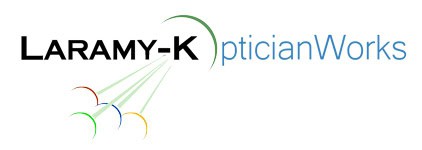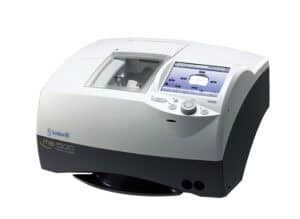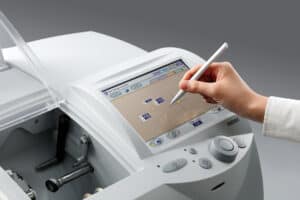Back to: 7: Finishing: The Optician’s Edge
Like everything else, edgers are becoming easier to work with and far more complex to work on. A modern edger is a combination of complex electronics, design software, computer guided hardware and user interfaces.
There are other combinations but, edgers will generally fall into one of two categories.
- Dry Edgers: Dry edgers use router bits to cut away the lens material. The waste removed becomes dust and the dust is collected through a vacuum system. A few companies still offer dry cut / vacuum edgers. To the best of my knowledge they are all quite low-end on features and inexpensive.
- Wet Edgers: Wet edgers use diamond covered wheels to grind away the lens material. The waste removed becomes a paste like substance and is washed away to be collected or passed through to the drain system.
- Dry Robotic (CNC) Edgers: Currently the state of the art and clearly where edging is headed. Although primarily found in the wholesale lab setting there are some in-house machines available.
Like everything else, each has its advantages and disadvantages and the type does not dictate quality or capabilities. Which you will choose will be your decision after working with company sales representatives and actually using the different types.
Edgers may have:
- Polishing: Which allows the edger to create a high luster edge on any lens. This is all done during the finishing process and the results are excellent and lens damage from heat and operator error are completely eliminated.
- Drilling: Which allows you to work from a template or custom design and drill the lens for creating three piece mounted frames.
- *Grooving: Which cuts the groove for use in semi-rimless mountings. The groove can be adjusted for both width and depth.
- Etching: Which creates an artistic design by lightly roughing the lens surface.
- Cut-outs: Which actually cut through the lens and rout a design.
- Custom, perfect match, clip-on or magnetic sun clip design programs.
- Faceting or Scalloping: Which creates a special cut edge along the circumference of the lens. Similar to to the facets you find on a diamond.
- Specialty design: The design software lets your imagination be the guide.
NOTE: *Bench top groovers are no longer available. Any edger purchase, new or used, must have the groove function. Don’t say I didn’t warn you.
The edger market is an odd one with different companies selling and cross selling different equipment under different brand names. The big names are currently, AIT, Briot, Coburn, Essilor, National Optronics, MEI and Santinelli. Just like car manufacturers, each of these companies will offer different models at different price points with different features.

For wet/wheel edgers I had amazing reliability and accuracy from the various Santinelli machines I had at work and on loan in the OpticianWorks Training Center. I can only speak to what I have actually worked with so I have no comparison to other makes and models. Honestly – I don’t think a Santinelli ever let me down once!
Their flagship model is the ME-1500
Their entry level is the LEXCE-Trend 8
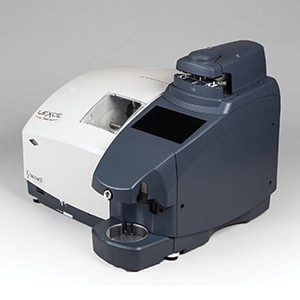

For in-house robotic edging capabilities look to MEI.
For more see: Visit MEI Website
You may recall my saying over and over that it is only a great edger that can overcome some poor power-to-frame matching. It is only a great edger that can cut for sophisticated mountings. Edgers like MEI’s can manipulate bevel placement to a much greater degree than wet/wheel edgers can. In fact, in the software you can zoom in and precisely choose your placement across the entire circumference of the lens!
Many shops are still operating fifteen, even twenty-five year old equipment, on a daily basis. An experienced operator can achieve consistent and accurate results on old manual equipment. However, modern equipment is far more accurate and less prone to errors in sizing than older equipment is.
To grasp the advantage of modern equipment over older equipment requires the ability to visualize or picture the finishing process in three-dimensions. Just like lenses, eyeglass frame eyewires are not symmetrical, and do not have consistent base curves.
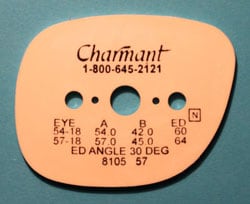
Pretty flat is it not?
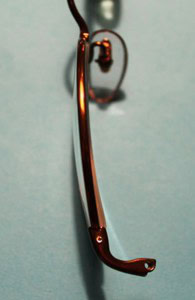
Notice how the frame curves?
If an edger traces and cuts on a single axis then the bevel will often be inconsistent with the actual curvature of the frame, making lens mounting difficult. These errors in lens bevel and frame curvature are compounded as prescription strength increases in both plus and minus lenses.
It is only when an edger can trace in multiple dimensions that it can create a bevel that will accurately match the frame. You will see the term “axis” used by the edger companies to describe the edgers ability to cut in more than one direction. For instance, “The Brenton-66, 4 Axis Edger, is the Best in Class.” There are only 3 dimensions so they use the term axis so it sounds better.

When it is finally time to purchase an edger. Have your sales representative cut and mount a full series of both plus and minus lenses in a variety of frames. Force the issue! Run high minus, high plus, grooves, rimless and a wide variety of frame sizes. Do NOT settle for the “demo”. You are making a purchase equal to a mid-priced new car! You wouldn’t buy that car without a thorough test drive would you?
Consider hitting the trade shows and watching them in action.
If you are considering adding edging to your store, buy the best you can. The better the edger, the better your ROI or return-on-investment will be.
Offering same day or even 30 – minute service is a great way to combat online sales. Having an edger that leaves you stranded and apologizing for work you promised and cannot provide is a great way to drive people to online sales!
Don’t say I didn’t warn you!
